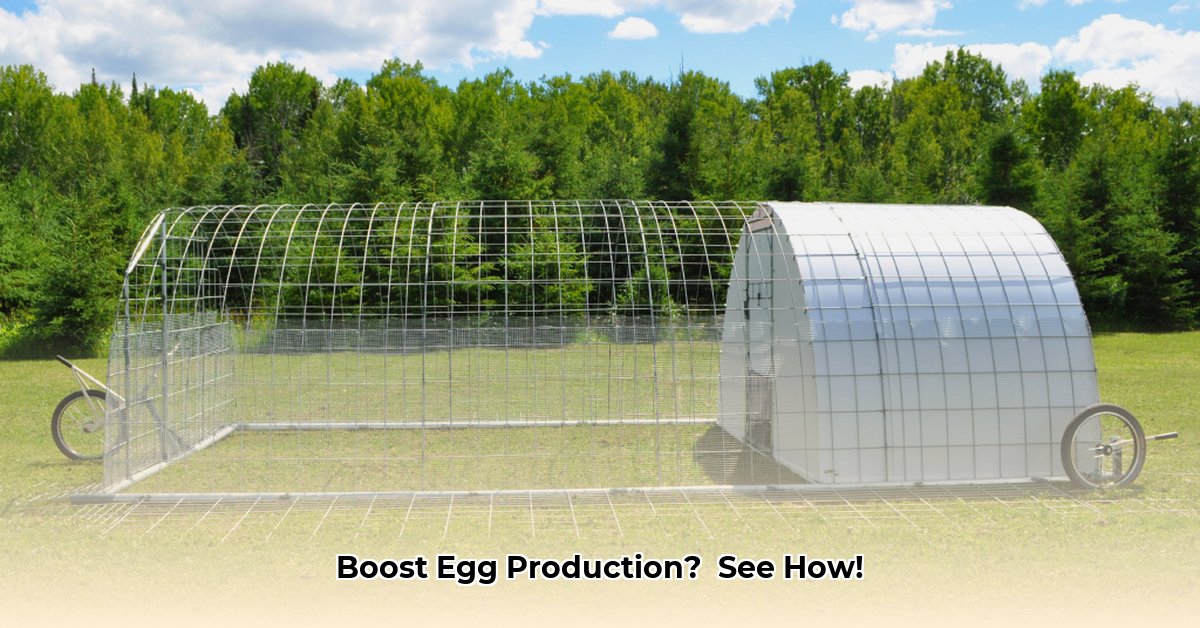
Movable Hoop Chicken Tractors: A Comparative Review and Instructional Guide
Want fresher eggs and happier, healthier hens? A movable hoop chicken tractor (a mobile chicken coop designed for pasture rotation) might be your answer! This isn't your grandmother's coop; it's a sustainable, mobile haven for your flock, surprisingly easy to build and maintain. This guide compares popular models (implicitly, Chicken Ranger and MeDeHoo) and provides a step-by-step instructional guide for building your own, focusing on materials, construction, biosecurity, and sustainable practices.
Are you ready to upgrade your poultry setup and enjoy the bounty of fresh, farm-fresh eggs?
For even more detailed plans, check out this helpful resource.
Planning Your Mobile Chicken Paradise: Size, Layout, and Budget
Before you start hammering, careful planning is essential. First, assess your flock size; more chickens require a larger coop. Consider your land's layout – flat terrain makes moving easier than hilly or obstacle-filled areas. Finally, establish a realistic budget; material costs vary considerably.
Next, choose a design. Numerous free plans are available online, adaptable to your needs and creativity. A simple hoop structure is a great starting point; it’s lightweight, durable, and easy to construct. Remember, excellent ventilation is crucial for a healthy flock; your chickens need ample fresh air to thrive. Poor ventilation can lead to respiratory problems and other illnesses. How will you ensure your coop has adequate airflow?
Gathering Your Supplies: A Comprehensive Material List
This list provides approximate quantities; adjust based on your design and coop size.
| Material | Quantity (Approximate) | Notes |
|---|---|---|
| PVC or Metal Pipes | 6-8 (depending on size) | Forms the arched frame; metal is stronger but heavier. |
| Heavy-duty Fabric | Enough for coop's area | Weatherproof fabric protects from sun, rain, and wind. |
| Wood | As needed | For frame reinforcement, base construction, and nesting boxes. |
| Wire Mesh (hardware cloth) | Enough for coop sides | Prevents predators (raccoons, weasels, etc.) from accessing your birds. |
| Wheels | 4 (or more, for larger coops) | Enables easy movement; sturdy wheels are best for uneven terrain. |
| Hinges, screws, etc. | As needed | Stainless steel offers superior durability. |
| Nesting boxes | 1 per 4-5 hens | Provides comfortable laying areas. |
Building Your Movable Hoop Chicken Tractor: A Step-by-Step Guide
Safety first! Always wear appropriate safety gear (gloves, safety glasses).
Step 1: Constructing the Hoop Frame: Carefully bend your pipes into arched hoops, forming the coop’s structure. Securely connect the hoops for stability. This is the skeleton of your chicken coop!
Step 2: Attaching the Protective Fabric: Drape the fabric over the frame, securing it tightly. Ensure a complete seal for protection from the elements. Strong straps or clips enhance security.
Step 3: Shielding Against Predators: Attach wire mesh to the sides, creating a predator barrier. Overlap mesh pieces for a secure seal.
Step 4: Adding Wheels for Easy Mobility: Attach the wheels to the base, ensuring smooth rotation for easy movement. Consider adding a handle for easier maneuvering, especially on uneven terrain. Did you know that regular coop relocation significantly reduces parasite loads?
Step 5: Creating Comfortable Nesting Boxes: Build and install nesting boxes inside, providing quiet laying areas. Use soft bedding such as straw.
Step 6: Finishing Touches and Testing: Double-check all connections. Test moving the coop to ensure smooth movement.
Maintaining Your Mobile Hen House: Cleaning and Regular Inspections
Regular maintenance is key. Clean the coop frequently to remove droppings and prevent bacterial buildup. Inspect the structure regularly for damage, replacing worn parts promptly. Regularly check the wire mesh for any holes or damage that might allow predators access. "Regular cleaning and inspection are crucial for maintaining biosecurity," says Dr. Emily Carter, Poultry Extension Specialist at State University.
Boosting Egg Production: The Power of Pasture Rotation
Movable hoop chicken tractors excel at pasture rotation. Relocating the coop regularly provides fresh pasture, supplying essential nutrients and improving flock health, leading to more and higher-quality eggs. Don't forget daily fresh water and feed! Studies show that pasture rotation can increase egg production by up to 20%.
Choosing the Right Mobile Chicken Coop: Key Considerations
Key Takeaways:
- Space: Adequate space is crucial (2.5-4 square feet indoors, 5-10 square feet outdoors per bird).
- Cleaning: Easy cleaning is vital for biosecurity. Consider designs with removable trays.
- Predator Protection: Secure construction, buried bases, and strong latches are essential.
- Mobility: Choose a coop weight and design suitable for your terrain.
- Materials: Material selection impacts durability and cleaning.
Building a movable hoop chicken tractor isn’t just about more eggs; it's about creating a sustainable, enriching environment for your chickens and improving your land management practices. It's a rewarding project that combines sustainable farming with the delicious reward of fresh eggs!